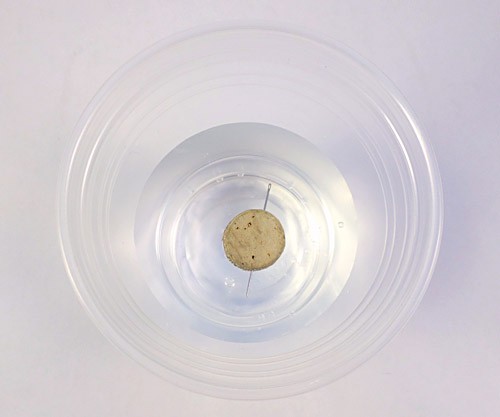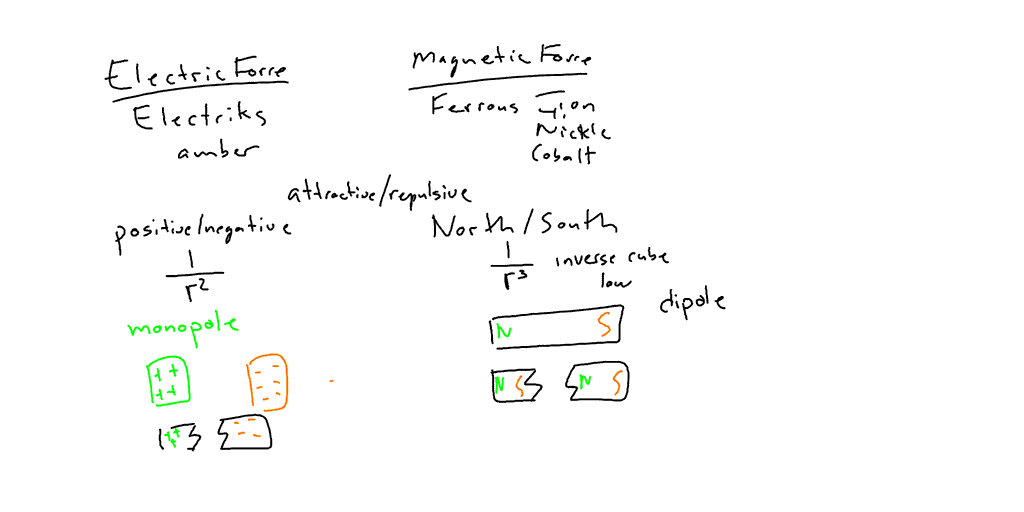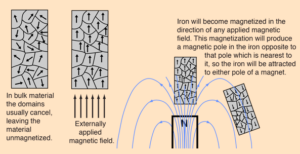Magnetic Poles
Thales (640 to 540 BCE), from Miletus (Turkey), collected rocks from Magnesia. He also collected amber (called elektron in Greek)
According to Aristotle:
“Thales, judging by what they report, seems to have believed that the soul was something which produces motion, inasmuch as he said that the magnet has a soul because it moves iron.”
The magnesian rocks he collected, or “ho magnetes lithos” (or lodestone) had the interesting property that the rocks were sometimes magnetized and could attract iron. Thales also realized that the magnetism could be transferred.
Obviously, it did not take long to realize that a magnetic needle in a cork floating in water, always winds up with the same end pointing north. Or if you lived in the Eastern Hemisphere, it generally seemed like due North.

Cork with a Magnetic Pin floating in water
Other interesting properties are that there are both North poles and South poles, where similar to the positive and negative charges and the electric force, opposite poles will attract, and like poles will repel. Anyone who has played with Brio or Thomas trains realized this at a very young age.
Most of our treatment for discussing the magnetic force will come later when we examine the Lorentz Force and how a magnetic field can affect moving charges and currents in wires. We won’t bother with a rigorous quantitative analysis of the interaction of two bar magnets. Although we could do an experiment and look at the inverse square law relationship between two poles, things are often made more complicated by the because there is no such thing as a magnetic monopole. Poles come in pairs called dipoles. Depending on the situation, we often have to deal with an inverse cube law when providing a rigorous analysis of dipoles.
But in class, you can see the action of magnetism as a force at a distance with the affects of a bar magnet on compasses and how this force does vary with distance.

Magnetic Domains
Why are some materials magnetic, and others not?
One distinct difference between electric charges and magnetic poles in how they are located. We can separate charges on an insulated rod, and place positive charges on one end, and negative charges on the other. If we then break the rod in half, each half will half a different charge.
 However, if we were to break a magnetic bar in half, instead we would have two pieces each with BOTH a North and a South pole. There is no such thing as a magnetic monopoles. They always come in pairs. You could easily demonstrate this by magnetizing a paper clip and cutting it in half.
However, if we were to break a magnetic bar in half, instead we would have two pieces each with BOTH a North and a South pole. There is no such thing as a magnetic monopoles. They always come in pairs. You could easily demonstrate this by magnetizing a paper clip and cutting it in half.
Early on, an entire class of materials with this property was discovered, the Ferromagnetic materials: Nickel, cobalt, iron, steel. But why not copper or aluminum? More on this later.
An idea developed that the bar magnet was made up of millions of tiny microscopic magnets called domains. And each domain has a North and a South pole. Normally, the domains in a ferromagnetic material would not be aligned. But if they are exposed to a strong magnetic field, then this ferromagnetic material becomes magnetized.
You can play with a java applet to demonstrate this at Professor Duffy’s Website from Boston University.
Hyperphysics has a great diagram for domains.
There are several ways to disrupt the domains once aligned. One way would be to expose the material to mechanical shock. Either by shaking it or smashing it. If you drop a magnet, this will indeed shake up the domains. Another way is by heating the material above a certain temperature known as the Curie Point, which was discovered by Pierre Curie in 1895. The Curie Point of iron is 760 C and hyperphysics has a full list of Curie temperatures.
Earth as a Magnet:
For a long time it was a mystery as to just why compass needles were attracted to the North Pole? Was there a huge mountain of iron to the far North? Maybe Santa used big magnets to control his elves and reindeer?
I mentioned earlier that a nice reading is William Gilbert of Colchester, physician of London:On the load stone and magnetic bodies. Gilbert discovered magnetic dip and recorded magnetic declination. By declination we mean that magnetic north and true north (the axis around which the Earth spins) are not the same. So if you were trying to navigate your compass would be off by a certain number of degrees given by the declination. This can be very important for explorers, and pilots of both planes and ships. Columbus noticed this as he sailed across the ocean blue. The lines of constant declination are called isogonic lines. If you happen to live in Chicago, the declination is almost zero.

This is also responsible for one of the greatest conspiracies of all time. For years, parents have been telling their children about a man named Santa Claus who delivers gifts to children on December 25th. Parents have falsely assumed that Santa does not exist, because the True North pole of Earth has been explored, and there is no one living there who meets this description. However, if one were to explore the magnetic north pole, they would be in for quite a surprise. Underneath the surface, in the basement of Santa’s workshop, there is a giant dynamo providing power to make all the toys. This generator is so powerful, that it creates a huge magnetic field which one can detect all over the Earth. This little known book by Henrietta Strickland explains the magnetic north pole conspiracy. And Santa is clever. So he cannot be found he keeps moving his workshop every winter.

The Christmas Bear’s North Pole
Because he moves his workshop, declination is varied over time. In fact, since I started teaching at B.U., the declination in Boston has changed by almost an entire degree. We have records of these changes going back millions of years by observing the iron deposits on the ocean floor. As molten iron comes out of the Earth, the domains are not aligned. As the molten iron cools, the domains align with the magnetic field of the Earth at that point in time.
Magnetic Fields:
In class we mapped magnetic field lines using compasses and/or iron filings. As with electric and gravitational field lines, when we do a rigorous sketch, we must include vector arrows, and we can draw the field lines going from North to South. The concept of magnetic field lines was developed by Michael Farday in 1831.
Although in one sense an abstract idea, we can quantify the number of these invisible field lines using a concept called Magnetic Flux. Magnetic Flux, Φ, is measured in Webers or Maxwells. One Maxwells is equal to one “line of force” and
1 Weber (Wb) = 1 million Maxwells
In our study we will more commonly use the magnetic flux density also known as the magnetic field strength.
The Tesla is the SI unit of magnetic flux density can be defined as
Magnetic Flux Density: B = Flux/area = Φ/A
Thus a Tesla, is a Weber/meter squared.
Magnetic Field in Materials
What happens in materials? There are some similarities to the dielectric constant’s relationship with the electric field in materials.
We can define a term called the relative magnetic permeability. In a vacuum the magnetic permeability, μ = 1
In a paramagnetic material, μ is a little larger than 1. The result is that an external magnetic field will slightly magnetize the material. Aluminum, Platinumm, Tungston, and Cesium are paramagnetic materials. However, when the external magnetic field is removed, the material loses is magnetization. In a diamagnetic material, μ is a little less than 1. A diamagnetic material reduces the magnetic field. Bismuth, Glass, sulfur, and rubber are examples of diamagnetic materials. A Superconductor is an example of a perfect diamagnetic material. A superconductor will perfectly expel the magnetic field, and thus has the ability to levitate. Most materials are naturally diamagnetic to some degree, unless there is a dominant paramagnetism or ferromagnetism.
A floating superconductor is a common physics classroom demonstration.
A less common example would be an object floating due to diamagnetism because of a super strong magnetic field. I like this example of a magnet repelled by two bismuth plates.
An object which is ferromagnetic is an extreme example of paramagnetism, which the relative permeability is in the thousands. A ferromagnetic material retains its magnetization after being exposed to a field. However, above its Curie point, a ferromagnetic material becomes paramagnetic.

